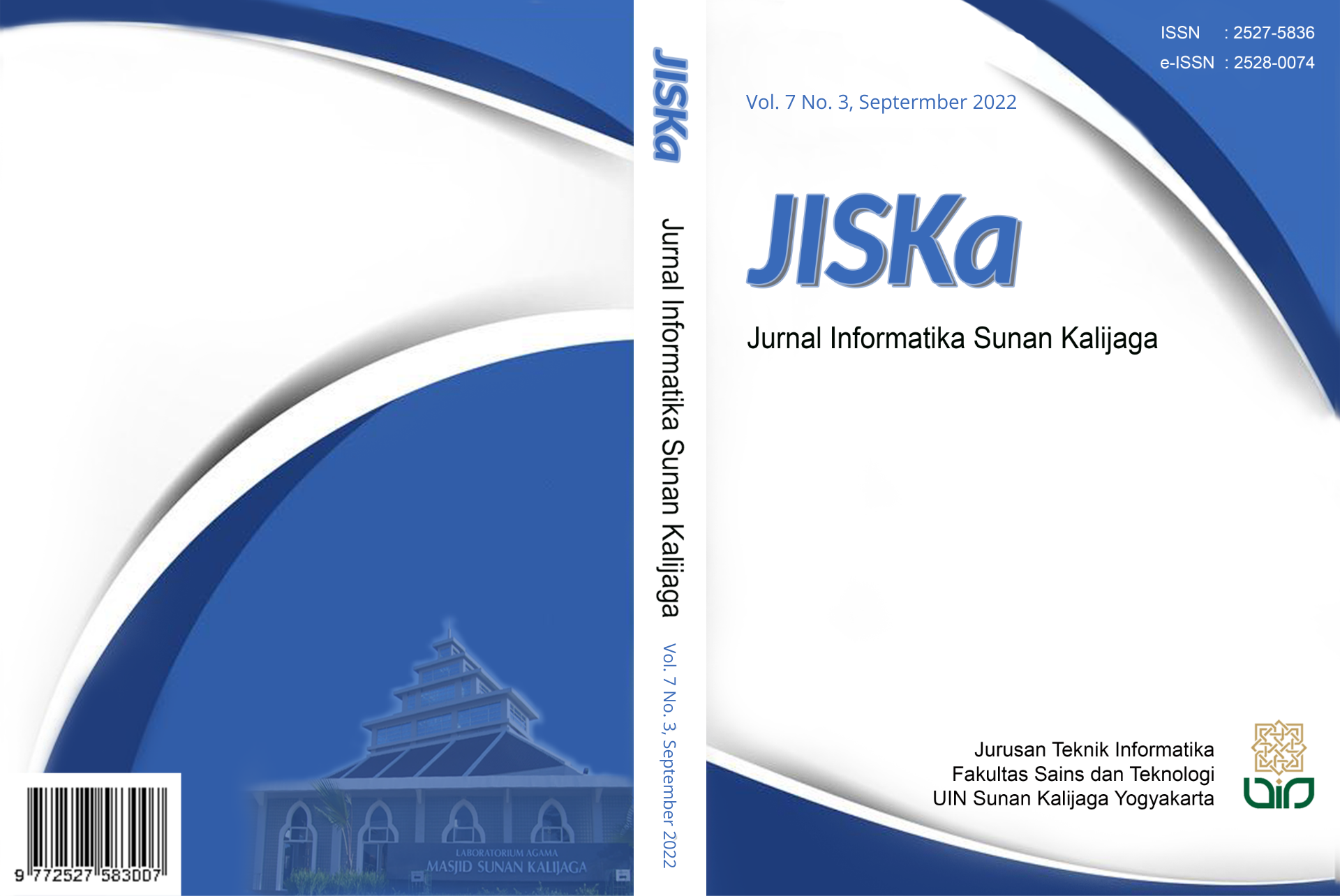Summarizing Online Customer Review using Topic Modeling and Sentiment Analysis
DOI:
https://doi.org/10.14421/jiska.2022.7.3.177-191Keywords:
User Generated Content, Online Customer Review, Text Mining, Topic Modeling, Sentiment AnalysisAbstract
With the massive implementation of social media in various forms in various business domains, business or product owners have the opportunity to be able to take advantage of user review data that is available free of charge to evaluate the products they issue. User reviews on social media platforms, marketplaces, and e-commerce are User Generated Content (UGC) which is very useful for product owners to find out the extent of user preferences for their products. However, to be able to comprehensively read the data, the right technology is needed considering that the data is in the form of text in very large quantities. Reading one by one and then drawing conclusions is certainly not the right approach because it will take quite a lot of time. So, in this study, the researcher will use a text analysis-based approach, especially topic modeling and sentiment analysis to summarize user reviews in the comments or reviews column on the e-commerce platform. The case study used in this study is user reviews in the comments column on the Amazon site for the Lenovo K8 Note smartphone product. From the experiments carried out, the approach used can summarize the reviews written by quite many users in one summary that can be easily understood.
References
Ahmad, M., Aftab, S., Muhammad, S. S., & Ahmad, S. (2017). Machine Learning Techniques for Sentiment Analysis: A Review. International Journal of Multidisciplinary Sciences and Engineering, 8(3).
Alghamdi, R., & Alfalqi, K. (2015). A Survey of Topic Modeling in Text Mining. International Journal of Advanced Computer Science and Applications, 6(1). https://doi.org/10.14569/IJACSA.2015.060121
Baccianella, S., Esuli, A., & Sebastiani, F. (2010). SENTIWORDNET 3.0: An enhanced lexical resource for sentiment analysis and opinion mining. Proceedings of the 7th International Conference on Language Resources and Evaluation, LREC 2010, 2200–2204.
Baharudin, B., Lee, L. H., & Khan, K. (2010). A Review of Machine Learning Algorithms for Text-Documents Classification. Journal of Advances in Information Technology, 1(1). https://doi.org/10.4304/jait.1.1.4-20
Balakrishnan, V., & Ethel, L.-Y. (2014). Stemming and Lemmatization: A Comparison of Retrieval Performances. Lecture Notes on Software Engineering, 2(3), 262–267. https://doi.org/10.7763/LNSE.2014.V2.134
Barde, B. V., & Bainwad, A. M. (2017). An overview of topic modeling methods and tools. 2017 International Conference on Intelligent Computing and Control Systems (ICICCS), 745–750. https://doi.org/10.1109/ICCONS.2017.8250563
Bashir, N., Papamichail, K. N., & Malik, K. (2017). Use of Social Media Applications for Supporting New Product Development Processes in Multinational Corporations. Technological Forecasting and Social Change, 120, 176–183. https://doi.org/10.1016/j.techfore.2017.02.028
Blei, D. M., Ng, A. Y., & Jordan, M. I. (2003). Latent Dirichlet allocation. Journal of Machine Learning Research, 3(4–5), 993–1022. https://doi.org/10.1016/b978-0-12-411519-4.00006-9
Bojanowski, P., Grave, E., Joulin, A., & Mikolov, T. (2017). Enriching Word Vectors with Subword Information. Transactions of the Association for Computational Linguistics, 5, 135–146. https://doi.org/10.1162/tacl_a_00051
Chehal, D., Gupta, P., & Gulati, P. (2021). Implementation and comparison of topic modeling techniques based on user reviews in e-commerce recommendations. Journal of Ambient Intelligence and Humanized Computing, 12(5), 5055–5070. https://doi.org/10.1007/s12652-020-01956-6
Cui, A. S., & Wu, F. (2017). The Impact of Customer Involvement on New Product Development: Contingent and Substitutive Effects. Journal of Product Innovation Management, 34(1), 60–80. https://doi.org/10.1111/jpim.12326
Elena, C. A. (2016). Social Media – A Strategy in Developing Customer Relationship Management. Procedia Economics and Finance, 39, 785–790. https://doi.org/10.1016/S2212-5671(16)30266-0
Elwalda, A., Lü, K., & Ali, M. (2016). Perceived derived attributes of online customer reviews. Computers in Human Behavior, 56, 306–319. https://doi.org/10.1016/j.chb.2015.11.051
Gimpel, K., Schneider, N., O’Connor, B., Das, D., Mills, D., Eisenstein, J., Heilman, M., Yogatama, D., Flanigan, J., & Smith, N. A. (2011). Part-of-speech tagging for twitter: Annotation, features, and experiments. ACL-HLT 2011 - Proceedings of the 49th Annual Meeting of the Association for Computational Linguistics: Human Language Technologies, 2, 42–47.
Greco, F., & Polli, A. (2020). Emotional Text Mining: Customer profiling in brand management. International Journal of Information Management, 51, 101934. https://doi.org/10.1016/j.ijinfomgt.2019.04.007
Hidayanti, I., Herman, L. E., & Farida, N. (2018). Engaging Customers through Social Media to Improve Industrial Product Development: The Role of Customer Co-Creation Value. Journal of Relationship Marketing, 17(1), 17–28. https://doi.org/10.1080/15332667.2018.1440137
Hu, S., Kumar, A., Al-Turjman, F., Gupta, S., Seth, S., & Shubham. (2020). Reviewer Credibility and Sentiment Analysis Based User Profile Modelling for Online Product Recommendation. IEEE Access, 8, 26172–26189. https://doi.org/10.1109/ACCESS.2020.2971087
Irawan, M. I., Wijayanto, R., Shahab, M. L., Hidayat, N., & Rukmi, A. M. (2020). Implementation of social media mining for decision making in product planning based on topic modeling and sentiment analysis. Journal of Physics: Conference Series, 1490(1), 012068. https://doi.org/10.1088/1742-6596/1490/1/012068
Jeong, B., Yoon, J., & Lee, J.-M. (2019). Social media mining for product planning: A product opportunity mining approach based on topic modeling and sentiment analysis. International Journal of Information Management, 48, 280–290. https://doi.org/10.1016/j.ijinfomgt.2017.09.009
Ko, N., Jeong, B., Choi, S., & Yoon, J. (2018). Identifying Product Opportunities Using Social Media Mining: Application of Topic Modeling and Chance Discovery Theory. IEEE Access, 6, 1680–1693. https://doi.org/10.1109/ACCESS.2017.2780046
Maheswari;, M. U., & Sathiaseelan, D. J. G. R. (2017). Text Mining: Survey on Techniques and Applications. International Journal of Science and Research (IJSR), 6(6), 1660–1664.
Mahr, D., Stead, S., & Odekerken-Schröder, G. (2019). Making sense of customer service experiences: a text mining review. Journal of Services Marketing, 33(1), 88–103. https://doi.org/10.1108/JSM-10-2018-0295
Mirtalaie, M. A., Hussain, O. K., Chang, E., & Hussain, F. K. (2018). Sentiment Analysis of Specific Product’s Features Using Product Tree for Application in New Product Development. In Lecture Notes on Data Engineering and Communications Technologies (Vol. 8, pp. 82–95). Springer Science and Business Media Deutschland GmbH. https://doi.org/10.1007/978-3-319-65636-6_8
Ng, C. Y., Law, K. M. Y., & Ip, A. W. H. (2021). Assessing Public Opinions of Products Through Sentiment Analysis. Journal of Organizational and End User Computing, 33(4), 125–141. https://doi.org/10.4018/JOEUC.20210701.oa6
Ramanathan, U., Subramanian, N., & Parrott, G. (2017). Role of social media in retail network operations and marketing to enhance customer satisfaction. International Journal of Operations and Production Management, 37(1), 105–123. https://doi.org/10.1108/IJOPM-03-2015-0153
Sun, F., Liu, J., Wu, J., Pei, C., Lin, X., Ou, W., & Jiang, P. (2019). Bert4rec: Sequential recommendation with bidirectional encoder representations from transformer. International Conference on Information and Knowledge Management, Proceedings, 11, 1441–1450. https://doi.org/10.1145/3357384.3357895
Suresh, R., & Harshni, S. R. (2017). Data mining and text mining — A survey. 2017 International Conference on Computation of Power, Energy Information and Commuincation (ICCPEIC), 2018-Janua, 412–420. https://doi.org/10.1109/ICCPEIC.2017.8290404
Syakur, M. A., Khotimah, B. K., Rochman, E. M. S., & Satoto, B. D. (2018). Integration K-Means Clustering Method and Elbow Method For Identification of The Best Customer Profile Cluster. IOP Conference Series: Materials Science and Engineering, 336(1), 012017. https://doi.org/10.1088/1757-899X/336/1/012017
Vijayarani, S., Ilamathi, J., & Nithya. (2018). Preprocessing Techniques for Text Mining - An Overview. International Journal of Computer Science & Communication Networks, 5(1), 7–16. https://doi.org/10.1016/j.procs.2013.05.286
Wang, L., Jin, J. L., Zhou, K. Z., Li, C. B., & Yin, E. (2020). Does customer participation hurt new product development performance? Customer role, product newness, and conflict. Journal of Business Research, 109, 246–259. https://doi.org/10.1016/j.jbusres.2019.12.013
Xun, G., Gopalakrishnan, V., Ma, F., Li, Y., Gao, J., & Zhang, A. (2016). Topic Discovery for Short Texts Using Word Embeddings. 2016 IEEE 16th International Conference on Data Mining (ICDM), 1299–1304. https://doi.org/10.1109/ICDM.2016.0176
Zhan, Y., Tan, K. H., & Huo, B. (2019). Bridging customer knowledge to innovative product development: a data mining approach. International Journal of Production Research, 57(20), 6335–6350. https://doi.org/10.1080/00207543.2019.1566662
Downloads
Published
How to Cite
Issue
Section
License
Copyright (c) 2022 Muhammad Rifqi Maarif

This work is licensed under a Creative Commons Attribution-NonCommercial 4.0 International License.
Authors who publish with this journal agree to the following terms as stated in http://creativecommons.org/licenses/by-nc/4.0
a. Authors retain copyright and grant the journal right of first publication with the work simultaneously licensed under a Creative Commons Attribution License that allows others to share the work with an acknowledgement of the work's authorship and initial publication in this journal.
b. Authors are able to enter into separate, additional contractual arrangements for the non-exclusive distribution of the journal's published version of the work (e.g., post it to an institutional repository or publish it in a book), with an acknowledgement of its initial publication in this journal.
c. Authors are permitted and encouraged to post their work online (e.g., in institutional repositories or on their website) prior to and during the submission process, as it can lead to productive exchanges, as well as earlier and greater citation of published work.










